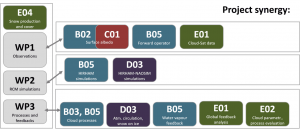PIs: Annette Rinke, Susanne Crewell, Gunnar Spreen
Snowfall is an integral part of the water cycle in the Arctic. It impacts snow accumulation on land and on sea ice affecting its seasonal growth and decay; it contributes to the freshwater input into the ocean and modulates the surface albedo, but such implications and the related feedback mechanismsare hardly studied. However, snowfall is extremely difficult to capture both in models and observations at the relevant regional spatial scales. Cloud radar observations by CloudSat available since 2006 have opened the possibility to investigate snowfall globally though with limited spatial coverage. In addition to existing and upcoming satellite radar observations, i.e., by the Global Precipitation Measurement (GPM) mission and EarthCare, we will exploit millimeter wave channels available on–board of operational weather satellites since more than 15 years. While they give excellent coverage in polar regions their use for precipitation retrieval is complicated as the signal also depends on the surface emissivity which is determined by surface types, e.g., sea water, ice, snow. Due to to days lack of adequate observations across the Arctic, snowfall is mainly taken from reanalysis and, thus, depends on model physics making it problematic to use it as the only source for the evaluation of Regional Climate Models (RCMs). To assess the ability of the models to reproduce physical processes driving precipitation variability in the Arctic, we will exploit the comprehensive active and passive millimeterwave satellite data set in two ways. The classical observation–to–model approach using snowfall retrievals will be complemented by a model–to–observation approach that creates synthetic observables, i.e., radar reflectivities and brightness temperatures, from RCM simulations. As the latter signal includes both the atmospheric snowfall as well as information on surface type, the interpretation is more complexand needs to take into account the different time scales of variability in the atmosphere and for surface. The consistency in the treatment of scattering between active and passive radiative transfer will allow to investigate the performance of the RCM cloud microphysical simulations with the comprehensive campaign data set of the TR 172 serving as a reference. Observations, new Arctic reanalysis at different spatial resolutions and a set of RCM simulations including a coupled atmosphere–ice–ocean Arctic RCM will be used to investigate the links between sea–ice reduction and cloud changes, the impact on snowfall, snowfall–to–precipitation ratio and the representation of observed snow cover variability and the associated dynamical relationships with atmospheric circulation.
Hypothesis: Changes in atmospheric conditions and sea-ice decline lead to consequences in regional snowfall patterns in the Arctic, which feed back to the sea ice.
In order to test the hypothesis, we will address the following central questions:
- What are the seasonal dependent regional patterns of snowfall, snowfall–to–precipitation ratio, snow cover, and their changes?
- What are the relationships between changes in snowfall and atmospheric conditions (warming, moistening, circulation changes) and sea–ice decline and do they trigger any regional feedback mechanisms?
Role within (AC)³
- Detailed investigations of clouds (B Cluster) and surface (C Cluster) processes as well as role of atmospheric circulation (D Cluster) are used for the integrative assesment of snow characteristics in the Arctic
- RCM simulations and data base of microwave radiances are shared with B05
- Close collaboration with all projects of the E Cluster on the integration of observations and models for better process & feedback understanding
Members
Dr. Annette Rinke
Principal Investigator
Alfred-Wegener-Institute Helmholtz Center for Polar and Marine Research (AWI)
Telegrafenberg A43
14473 Potsdam
Prof. Dr. Susanne Crewell
Principal Investigator
University of Cologne
Insitute for Geophysics and Meteorology (IGM)
Pohligstr. 3
50969 Cologne
Dr. Gunnar Spreen
Principal Investigator
University of Bremen
Institute for Environmental Physics (IUP)
Otto-Hahn-Allee 1
28359 Bremen
Dr. Erlend Moster Knudsen
Postdoc
University of Cologne
Insitute for Geophysics and Meteorology (IGM)
Pohligstr. 3
50969 Cologne
Josephine Förster
PhD
Alfred-Wegener-Institute Helmholtz Center for Polar and Marine Research (AWI)
Telegrafenberg A43
14473 Potsdam
phone:
++49 (0) 331 288 2153
e-mail:
josephine.foerster[at]awi.de
-
Prof. Dr. Roel Neggers Principal Investigator
University of Cologne
Institute for Geophysics and Meteorology (IGM)
Pohligstr. 3
50969 Colognephone: ++49 (0) 221 4701614
e-mail: neggers[at]meteo.uni-koeln.de



